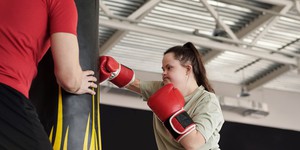Tightening the Turns in Speed Skating: Lessons in Centripetal Force & Balance
Abstract
Enjoy the thrill and pace of speed skating, do you? Well, this project's for you. Fast turns around the track become your laboratory tests in these experiments whether you skate on ice, wood, or pavement. The goal is to determine which type of turns are best in a race-tight, medium, or wide-and then to figure out why. You'll analyze the speed and stability of your turns and compare your results with those of a few fellow skaters. This is a friendly competition where the prize is learning science while having fun on your skates. On your mark, get set, go!Summary
Darlene E. Jenkins, Ph.D.
This project is based on a DragonflyTV episode.Objective
The goal of this project is to determine which type of turn-tight, medium, or wide-is best in speed skating.
Introduction
It's all about time for a speed skater. Getting around the track, whether it's ice or a wooden floor, in the fastest time and with the most control usually means finishing the race with a gold, rather than silver or bronze medal. The straightaway sections are critical for picking up speed, but it's the turns that can really determine the outcome of a competition. That's where a skater must concentrate to keep the precise amount of "lean" into the track balanced with fast and powerful cross-over foot work to make the turn tight and fast. One slight slip of the blade or wheels and the skaters may find themselves sliding way out of line or, even worse, careening right off the track.
Whether it's ice, wood, or a paved surface, the science that governs a skater's ability to turn is essentially the same. It's based on a couple of basic laws of physics that describe speed and the circular motion of turns. The first is Newton's law of inertia that says a body in motion will stay in motion unless there is some outside force that changes it. To skaters hoping to make a turn after they speed down the straightaway, that means the force of inertia would tend to keep them going straight ahead if there wasn't a greater force to make them change direction and begin turning.
The force that causes the change in direction comes from the skater's blades or wheels as they cross over at an angle in front of the skater leaning to make a turn. Newton's law of reaction explains that the push from the skater's skates generates an equal but opposite push back from the ice or floor. This push back force draws the skater in towards the track and is described as a "center seeking" or centripetal or type of force. It's the reason why turns are possible in any sport. The wheels of a bicycle, for example, also angle into the road surface when the cyclist leans to begin a turn. As the road pushes back on both bike and rider, it supplies the inward centripetal force to generate the turning motion.
The more a skater leans into a turn, the more powerful the push from the skate, and the greater centripetal force produced to carry the skater through the turn. Leaning in also creates a smaller arc, or tighter turn, making for a shorter distance and a faster path around the turn. However, there's a catch. As the skater leans more and more into the track, the balancing point of the body, or the skater's center of gravity, also shifts more and more to the side. If it shifts too far, the skater no longer can maintain balance and ends up splayed out onto the rink rather than happily heading round the turn to the finishing line.
So success in turns, especially fast ones, means skaters must constantly find their center of gravity while teetering on the edge of their skates. To make the turn at all, requires that the skater push the skates against the ice with sufficient power to generate enough inward centripetal force to counter the inertia of skating straight ahead. And to keep up speed in a race, a skater must calculate and execute the shortest, or tightest, turns possible around the track. Imagine all that science going on when skaters thought they were just racing and having fun!
To better understand the physics of skating and making turns, do some background research before you begin your project. You'll find a list of suggested search terms, basic questions and a helpful bibliography in the next sections to get your started. Then gather up your friends and skates and head out to the rink or track. Who knows, maybe your skating times and turns will benefit from your new-found scientific knowledge of inertia, center of gravity, and centripetal force.
Good luck, have fun in the turns, and may the (centripetal) force be with you!
Terms and Concepts
To do this project, you should do research that enables you to understand the following terms and concepts:
- Physics of skating
- Center of gravity (center of mass)
- Circular motion
- Centripetal force
- Inertia (Newton's first law of motion)
- Law of action and reaction (Newton's third law of motion)
Questions
- How do tight turns and wide turns affect a skater's speed and stability when racing?
- Define center of gravity. Describe how a skater's center of gravity shifts when leaning in to make a tight turn.
- What is centripetal force?
- How is centripetal force important when making a turn?
- Explain the relationship between inertia and centripetal force when a skater is making a turn.
Bibliography
Here are some websites you might want to check out as you start your research:
- Basic explanation of centripetal force, inertia, and acceleration:
Henderson, T., 2007a. Lesson 1: Motion Characteristics for Circular Motion, The Physics Classroom Tutorial. Retrieved February 7, 2011. - Good explanations of the physics of turns in skating and other sports:
Henderson, T. 2007b. Lesson 2: Applications of Circular Motion, The Physics Classroom Tutorial. Retrieved February 7, 2011. - The idea for this project came from this DragonflyTV episode:
TPT, 2006. Speedskating by Sarah, Lisa, Ned and Eric. DragonflyTV, Twin Cities Public Television. Retrieved July 22, 2011.
Materials and Equipment
To do this experiment you will need the following materials and equipment:
- Four skaters
- Helmet for each skater
- Standard 110 meter track at an ice rink, roller rink, or smooth open parking lot
- Ice skates, in-line skates, or roller skates
- Plastic cups or soda bottles to mark the course
- Stop watch
- Note book or paper
- Pens or pencils
Note: For ISEF-affiliated science fairs, studies involving human subjects require prior approval. For more information, see Projects Involving Human Subjects.
Experimental Procedure
- Decide where you will hold your experiments. Use a standard ice hockey 110 meter short track or some equivalent sized track for in-line or roller skates.
- Tell the three people you recruited for in your experiment the date and time you wish to start the experiment.
- The day of the experiment, set up six plastic cups or soda bottles as equally spaced markers around the inner edge of one turn of the track. The markers should start and end at the points where the turn straightens out on both sides.
- Have everyone take a few warm up labs around the track.
- Do the following three experiments. Time, to one-tenth of a second, how long it takes each skater to travel from the first marker around the entire turn to the second marker.
- Experiment 1: Tight turns (as close as possible to the turn markers)
- Experiment 2: Medium turns (one step out from the tight turn position)
- Experiment 3: Wide turns (two steps out from the tight turn position)
- Each skater should do ten tries for each type of turn.
- At the end of each try, ask the skater to rank how stable they felt during that turn. Use a numerical system like 0 = fell down; 1 = almost falling; 2 = very wobbly; 3 = slightly wobbly; 4 = stable with no problems.
- Record the time and stability results for each skater in all three experiments in your notebook.
Analyzing Your Data
- Total the ten trial times of each skater in each experiment. Calculate an average time for each skater in Experiment 1, 2, and 3.
- Total the stability scores of each skater in each experiment. Calculate an average stability score for each skater in each experiment.
- Prepare a bar graph showing the average time for all skaters in Experiment 1, 2, and 3.
- Indicate above each bar, how the skater rated their average stability during the skate using the individual average stability scores.
- What differences do you see between the skaters' average times in Experiment 1, 2, 3? Did all skaters have fairly similar times? If not, how were the times different between the skaters. Can you explain why?
- What differences do you see between the skaters' stability ratings of Experiment 1, 2, 3? Are the results consistent between the skaters?
- Is there any correlation between stability ratings and speed for each type of turn?
- What type of turn seemed the best for each skater?
- For help with data analysis and setting up tables, see Data Analysis & Graphs.
- For a guide on how to summarize your results and write conclusions based on your data, see Conclusions.
Ask an Expert
Variations
- Try a Circle. Repeat these experiments with a round track instead of an oval track. Do you see similar results on which type of turning technique is best? Use your knowledge of centripetal force and the physics of turns to explain your results.
- Try a Different Track Surface. Repeat these experiments on a track surface different from what you usually skate on. For example, if you are an ice speed skater, try the experiment using in-line skates on a wooded or paved track. Or repeat the experiments with four other skaters that skate on a different surface. Compare their results to your experiments and explain any differences.
- Do the Math. Research the equations describing circular motion and the relationships between acceleration, radius of a track, mass of the traveling object, and angle of the lean. Also read about vector principles and how they apply to turns in a sport like speed skating. Use these concepts and equations to demonstrate the mathematical differences between making tight, medium, and wide turns around your size track.
- For a simple demonstration of centripetal force, see the Science Buddies project Centripetal Force.
Careers
If you like this project, you might enjoy exploring these related careers:
Related Links
- Science Fair Project Guide
- Other Ideas Like This
- Sports Science Project Ideas
- My Favorites
- Projects Involving Human Subjects










